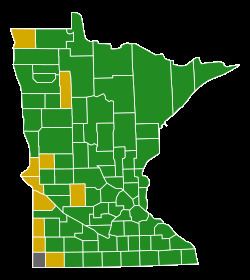November 8, 2016 2020 → 10 0 46.44% 44.92% | Turnout 74.72% 1,367,716 1,322,951 Date 8 November 2016 | |
 | ||
Clinton
40-50%
50-60%
60-70% Trump
40-50%
50-60%
60-70%
70-80% | ||
The 2016 United States presidential election in Minnesota was held on November 8, 2016, as part of the 2016 general election in which all 50 states plus the District of Columbia participate.
Contents
- Democratic caucuses
- Republican caucuses
- Green caucuses
- Libertarian caucuses
- Candidates
- Analysis
- Results
- References
On March 1, 2016, in the precinct caucuses, Minnesota voters expressed their preferences for the Democratic, Republican, Green and Libertarian parties' respective nominees for President.
Minnesota was won by Democratic nominee Hillary Clinton by a 1.5% margin, making this the closest presidential election in Minnesota since 1984 when it was the only state not to give its electoral votes to Ronald Reagan. Trump managed to defeat Clinton in the national election by performing strongly in the Great Lakes states, winning the traditionally Democratic states of Wisconsin, Michigan, and Pennsylvania. However, he still narrowly failed to win Minnesota, which has not voted for a Republican since Richard Nixon in 1972.
Democratic caucuses
Bernie Sanders received the most votes and the most delegates in the precinct caucuses.
The 2016 turnout was slightly lower than the 2008 tally of 214,066, when Obama won with 142,109 votes, to Clinton's 78,381.
Bernie Sanders won every congressional district in Minnesota.
Republican caucuses
The 38 delegates from Minnesota were allocated in this way. If a candidate received more than 85% of the vote, they would get all of 38 delegates. Otherwise, 24 delegates would be allocated proportionally based on the votes per congressional district (3 votes per district). On top of that, there were 10 at-large delegates and 3 party leaders (the National Committee Man, the National Committee woman, and the chairman of the Minnesota Republican Party). All of the at-large delegates were allocated proportionally based on the popular vote with a mandatory threshold of 10% to receive any delegates; if no one got at least 10%, all candidates would be eligible to get delegates.
Some media outlets recorded the votes by congressional district, rather than by county. Rubio won districts 1, 2, 3, 4 and 5 in the Minneapolis-Saint Paul area as well as the southern part of the state. Cruz slightly won districts 6, 7 and 8 in the St. Cloud area and rural north.
Green caucuses
The Green Party of Minnesota held caucuses on March 1 in Saint Paul, Minneapolis, Bemidji, White Bear Lake, Blaine, Grand Rapids, and Willmar. Jill Stein won the caucuses with 84.3% of the vote. The delegates apportioned to each candidate will be decided at the state convention in St. Cloud, Minnesota in June. The results of the caucuses are as follows:
Libertarian caucuses
The Minnesota caucus was run on March 1, 2016, using ranked choice voting. Gary Johnson took over 75% of the 226 first-preference votes cast, with John McAfee a distant second on 11.5% and Austin Petersen third on 7.5%.
Candidates
The following have write-in status:
Analysis
Minnesota swung 6.2% Republican from the 2012 presidential election, a much larger shift than the nation at large, even though Donald Trump received 359 fewer votes and a smaller percentage (0.7%) than Mitt Romney in 2012. Hillary Clinton also received fewer votes in the state than any Democratic candidate since Al Gore in 2000, and a smaller percentage of the total vote than any candidate since Bill Clinton in 1992. Notably, this election marked the first time since 1952 that the Democratic candidate performed worse in Minnesota than in the nation at large. Hillary Clinton won the national popular vote by 2.1% but won Minnesota by just 1.5%, or 42,683 votes. Minnesota has been a primarily Democratic state in national elections since 1932.
Due to the Republican gains made by Trump throughout the state, Clinton was dependent on her wins in Hennepin (Minneapolis) and Ramsey (St. Paul) counties, the two most populous counties in the state, and the Arrowhead Region in the northeastern corner of the state.
Results
Source:
